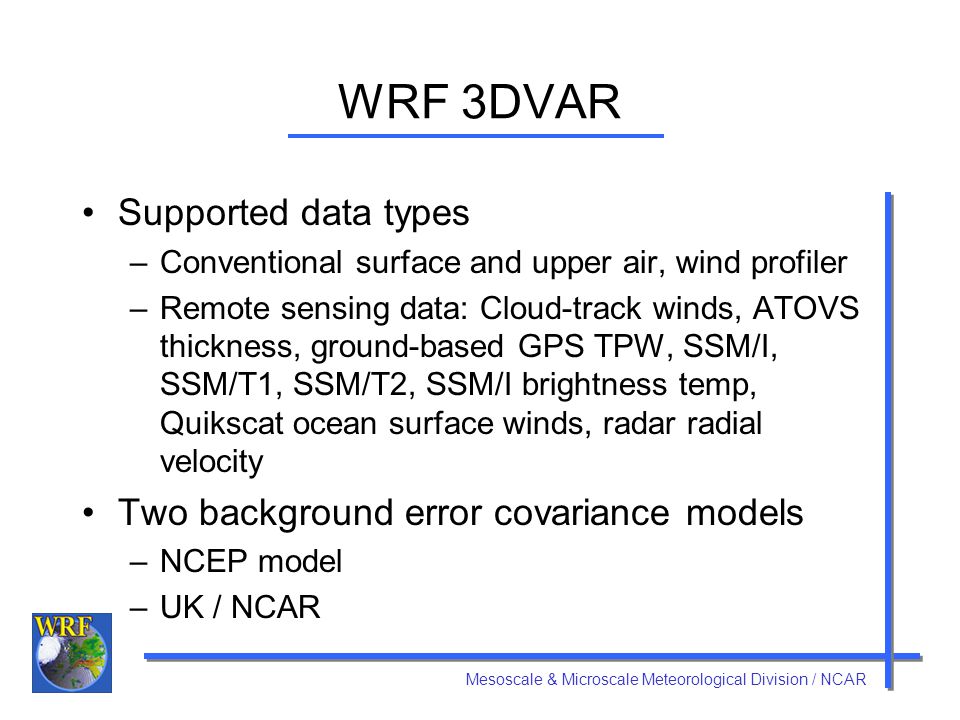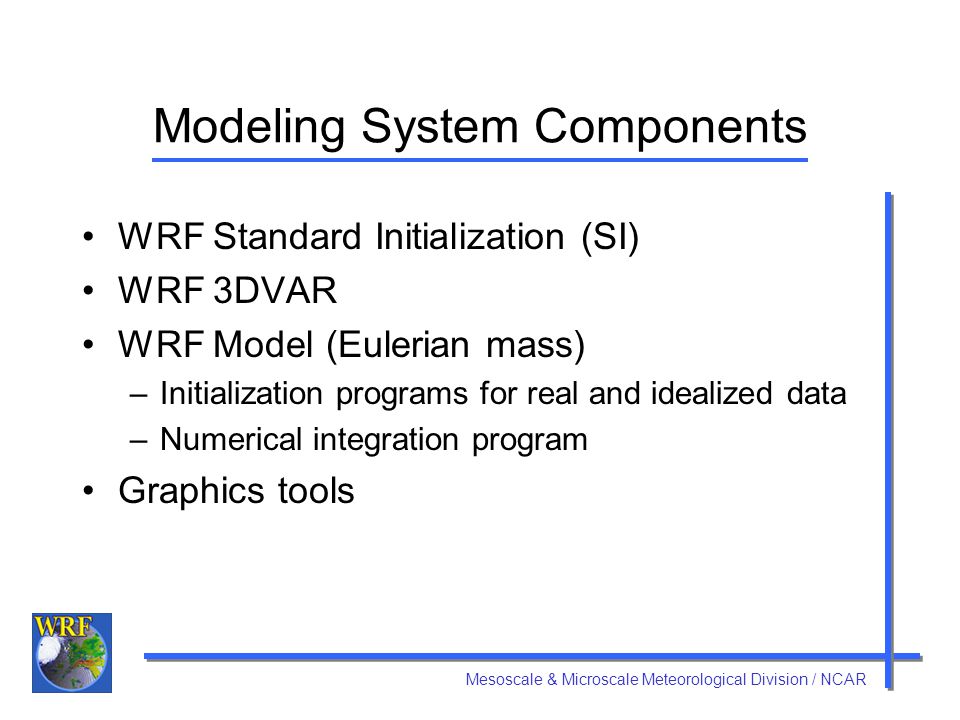This means that the four experiments produce underestimated rainfall accumulations for Event A, but overestimated rainfall accumulations for Event B. A larger CV value represents higher variability thus less even rainfall distribution. It is found that better and more detailed information is added to the initial fields e. In Figure 9 b for event B, the precipitation intensity in CTRL experiment is significantly larger than the measured values in first 6 hours. Variational Var data assimilation achieves this through the iterative minimization of a prescribed cost or penalty function [ 28 ]: 
| Uploader: | Dataxe |
| Date Added: | 28 September 2013 |
| File Size: | 31.20 Mb |
| Operating Systems: | Windows NT/2000/XP/2003/2003/7/8/10 MacOS 10/X |
| Downloads: | 12199 |
| Price: | Free* [*Free Regsitration Required] |
The rain-gauge data were used to analyze the changed precipitation area and accumulation after data assimilation experiments. Event A is chosen to evaluate the impact of data assimilation on the initial 3dvvar. The forecast precipitation for Event A from the different numerical experiments: For the two events, the cumulative curve in DA-BOTH experiment is closest to the curve of the measured values, while in DA-OBS experiment the accumulation curves are far below to the curve of the measured values, due to the lack of ground observations in the high-altitude region.
Table of Contents Alerts. In DA-OBS experiment Figure 5 cprecipitation accumulation on the northwestern of the region is greater than that in CTRL experiment, but the precipitation area is similar in both experiments. But for the wrrf variation, the improvement is more obvious for the event with even rainfall distribution in time, while the effect of data assimilation is not ideal for the rainfall event with uneven distribution in space and time.
However, the modeling accuracy is negatively affected by errors in the initial conditions. Additionally, many investigations have shown d3var rainfall forecasts from the NWP models can be improved noticeably with the assimilation of radar reflectivity [ 17 — 19 ] or radar-derived precipitation data [ 2021 ].
WRFDA Users Site
Details of the observed data used in the assimilation experiments. In conclusion, both for the spatial and temporal distribution of rainfall, the satellite radiances have greater effect than surface and upper-air meteorological observations in high-latitude regions of the northeastern edge, and the improvement for the assimilation of satellite radiances together with surface and upper-air meteorological observations is greater than that for assimilating either satellite radiances or meteorology observations.
Variational Var data assimilation achieves this through the iterative minimization of a prescribed cost or penalty function [ 28 ]: By comparing the evenness of the rainfall distribution in time and space in Figures 3 and 4it can be found that Event A has even rainfall distribution neither in space nor in time.
Location map showing the northeastern edge of the Tibetan Plateau and 44 observation stations. This may be because there are few stations located on the high-altitude region of northeastern Tibetan Plateau.
In order to 3cvar quantitatively the impact of data assimilation experiments which have positive effects on the rainfall forecast, rain-gauge data from 43 sites were used. Differences between rainfall values measured at the sites and those from the numerical experiments for Event A: View at Google Scholar 3dcar. WRF is a nonhydrostatic, primitive-equation, mesoscale meteorological model with advanced dynamics, physics, and numerical schemes details of the model is at http: Two heavy rainfall events with different evenness in space and time are used to examine the improvement for rainfall forecast.
The CTRL experiment predicts only a small amount of rainfall on the northwestern of the study area, while in DA-SAT experiment precipitation area extends to the central and southern regions of the study area and rainfall accumulation increases significantly Figure 5 b.
The results of the data assimilation experiments are presented and evaluated in Section 4and conclusions are given in Section 5. The numerical qrf prediction NWP is gaining more attention in providing high-resolution rainfall forecasts in the arid and semiarid region. The results for Event B are shown in Figure 6. Rain-gauge data from 43 sites were used to evaluate the impact after data assimilation.

The numerical data assimilation experiments in this study are conducted using the Advanced Research WRF model Version 3. The region with the largest changes is mainly located in Qinghai Province and the northwest of Gansu Province, which is consistent 3dvad the improved forecasts of precipitation area and accumulation in DA-BOTH experiment. However, in DA-SAT experiment, the green triangles which represent the observation sites Qilian, Yeniugou, Tuole, and Wulan in the central and southern regions of the study area arf closer to the line Figure 7 b.

The projection method is Lambert. The background error covariance matrix is generated via the National Meteorological Center NMC method [ 30 ] for our own forecasting domain. The greater difference between Event A and Event B is the rainfall distribution in time.
Advances in Meteorology
This is an open access article distributed under the Creative Commons Attribution Licensewhich permits unrestricted use, distribution, and reproduction in any medium, provided the original work is properly cited. But in the northwest of the region, the rainfall accumulation for DA-SAT experiment 3evar similar with that shown in Figure 5 a.
Figure 3 illustrates the spatial distribution of the rainfall accumulation for the durations of the two events, while Figure 4 presents the time series wrr and the cumulative curves of the observed precipitation for the two events at Laohugou station. It is found that better and more detailed information is added to the initial fields e. The rainfall intensities and cumulative 3dvaar of the values measured at the sites and the simulated results from the four numerical experiments: For the spatial distribution, data assimilation experiments changed significantly the rainfall area and accumulation for the study area.

No comments:
Post a Comment